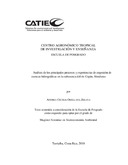| dc.contributor.author | Orellana Zelaya, A.C. | |
| dc.date.accessioned | 2014-10-17T06:05:04Z | |
| dc.date.available | 2014-10-17T06:05:04Z | |
| dc.date.issued | 2010 | es_ES |
| dc.identifier | 374863 | es_ES |
| dc.identifier.uri | https://repositorio.catie.ac.cr/handle/11554/392 | |
| dc.identifier.uri | http://orton.catie.ac.cr/repdoc/A4975e/A4975e.pdf | es_ES |
| dc.description | Tesis (M. Sc) -- CATIE, Turrialba (Costa Rica), 2010 | es_ES |
| dc.description.abstract | institucionafidad, gobernanza y gobernabilidad gestión territorial del agua mecanismos de financiamiento y escalamiento territorial, para finalmente elaborar una propuesta de fortalecimiento del mismo. Los componentes de mayor contribución al modelo han sido la planificación y el de institucionalidad, gobernanza y gobernabilidad, pues según el análisis de dinámica de sistema, la mayoría de los componentes se afectan unos a otros de manera positiva, generando un “efecto en cadena†en todo el modelo. Basado en los resultados anteriores, se proponen estrategias y acciones a desarrollar en los diferentes componentes de modelo de cogestión a fin de seguir consolidando y fortaleciendo la implementación del mismo. El estudio tuvo por objetivo analizar ios principales procesos y experiencias del modelo de cogestión de cuencas hidrográficas implementado por el CATIE en conjunto con múltiples actores locales, en la subcuenca del río Copán en Honduras. El análisis se realizó con base en los cinco componentes principales del modelo: planificación y monitoreo The study aimed to analyze the main processes and experiences of co-management model watershed implemented by CATIE in conjunction with many local actors in the Copan river sub watershed, Honduras. The analysis was based on five main components of the model: planning and monitoring, institutional, governance and governance, territorial water management, financing mechanisMON and spatial scaling, to finally develop a proposal to strengthen the model. The greatest components of contribution to the model have been planning and the institutional, governance and institutions, as most of the components affect each other positively, creating a ripple effect throughout the model. Based on previous results suggests strategies and action plans in the different components of co-management model in order to further consolidate the same. | es_ES |
| dc.language.iso | es | es_ES |
| dc.publisher | Centro Agronómico Tropical de Investigación y Enseñanza, Turrialba (Costa Rica) | es_ES |
| dc.subject | CUENCAS HIDROGRAFICAS | |
| dc.subject | ORDENACION DE CUENCAS | |
| dc.subject | PLANIFICACION | |
| dc.subject | AGUA | |
| dc.subject | GESTION AMBIENTAL | |
| dc.subject | FINANCIAMIENTO | |
| dc.subject | ENTORNO SOCIOECONOMICO | |
| dc.subject | SOSTENIBILIDAD | |
| dc.subject | TOMA DE DECISIONES | |
| dc.subject | HONDURAS | |
| dc.title | Analysis of the main processes and experiences of co-management of watersheds in the Copan river sub watershed, Honduras | es_ES |
| dc.title.alternative | Análisis de los principales procesos y experiencias de cogestión de cuencas hidrográficas en la subcuenca del río Copán, Honduras | es_ES |
| dc.type | Tesis de maestría | es_ES |
| dc.identifier.publication | Turrilaba (Costa Rica) | es_ES |


